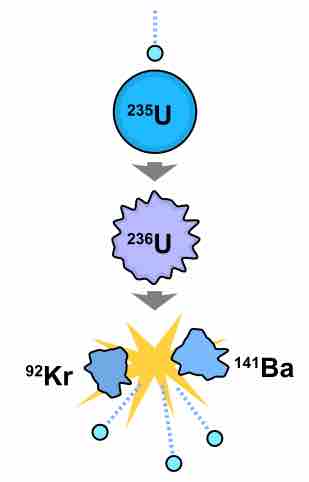Nuclear fission is a process by which the nucleus of an atom is split into two or more smaller nuclei, known as fission products. The fission of heavy elements is an exothermic reaction, and huge amounts of energy are released in the process. The nuclei produced are most often of comparable but slightly different sizes, typically with a mass ratio of products of about 3:2 for common fissile isotopes. Most fissions are binary fissions that produce two charged fragments. Occasionally, about 2 to 4 times per 1000 events, three positively charged fragments are produced, which indicates a ternary fission. The smallest of these fragments in ternary processes ranges from the size of a proton to the size of an argon nucleus.
Origin of Nuclear Instability
Within the nucleus, there are different forces that act between the particles. The strong nuclear force is the force between two or more nucleons. This force binds protons and neutrons together inside the nucleus, and it is most powerful when the nucleus is small and the nucleons are close together. The electromagnetic force causes the repulsion between like-charged protons. These two forces produce opposite effects in the nucleus. The strong nuclear force acts to hold all the protons and neutrons close together, while the electromagnetic force acts to push protons further apart.
In atoms with small nuclei, the strong nuclear force overpowers the electromagnetic force. As the nucleus gets bigger, the electromagnetic force becomes greater than the strong nuclear force. In these nuclei, it's possible for particles and energy to be ejected from the nucleus. These nuclei are called unstable, and this instability can result in radiation and fission.
Neutron Bombardment
In order to initiate fission, a high-energy neutron is directed towards a nucleus, such as 235U. The combination of these two produces 236U, which is an unstable element that undergoes fission. The resulting fission process often releases additional neutrons, which can go on to initiate other 235U atoms, forming a chain reaction. While nuclear fission can occur without this neutron bombardment, in what would be termed spontaneous fission, this is a rare occurrence; most fission reactions, especially those utilized for energy and weaponry, occur via neutron bombardment. If an element can be induced to undergo fission via neutron bombardment, it is said to be fissile .

Nuclear fission of U-235
If U-235 is bombarded with a neutron (light blue small circe), the resulting U-236 produced is unstable and undergoes fission. The resulting elements (shown here as Kr-92 and Ba-141) do not contain as many nucleons as U-236, with the remaining three neutrons being released as high-energy particles, able to bombard another U-235 atom and maintain a chain reaction.